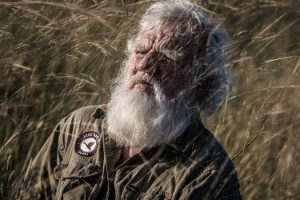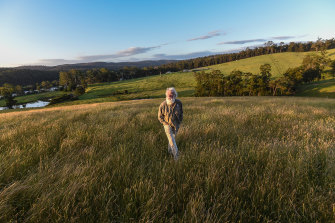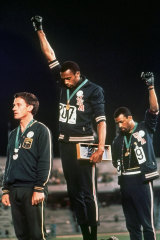Call for conversation not screaming match about Aboriginal history

The last Australian male to win an Olympic medal for the 200 metres was Peter Norman in Mexico in 1968. On the podium with him were the gold and bronze medallists, two African-Americans.
The Americans raised their fists in the Black Power salute. The cheers of the crowd immediately turned to heckling and then horrible insults. It was the height of the Black Panther movement in the US.
Yuin man Bruce Pascoe on his property Yumburra near Mallacoota. The Black Summer bushfires burned much of his property. The two large paddocks where he grows Australian grasses were also burned but have surged back stronger than ever.Credit:Justin McManus
Norman was aware that his fellow runners would protest and wore a human rights badge in solidarity. He didn’t raise his fist, but he wanted to support the justice of their human rights.
All three were ostracised by the Olympic movement and vilified by the media in their home countries. Norman was first abused and then ignored by his country. Whereas other Olympians were lauded on their return to Australia, he was shunned for the rest of his life despite his Mexican run not having been bettered in Oceania to this day.
American athletes Tommie Smith, centre, and John Carlos extended gloved hands in a protest at the Mexico City Games in 1968. Silver medallist Australia’s Peter Norman stands on the left. He wore a badge supporting the “Olympic Project for Human Rights”.Credit:AP
The world loves a sportsperson, until they get political. As John Carlos, the bronze medallist, said: “We are afraid to offend the oppressor.” We are supposed to forget some parts of our history and if we don’t some consider us enemies of the state.
When my uncle encouraged me to follow the family heritage I was amazed at how quickly that led me into foreign territory. This was an Australian history for which my education had not prepared me, a story of murder, oppression and disdain.
Most families I spoke to mentioned massacres as others might mention migration. In talking of the late 1800s and 1900s, stolen children became a punctuation mark for the same families.
I began to visit libraries so that I could re-educate myself. The information wasn’t hard to find but I was puzzled by the complete lack of reference to this material in Australian public life or schooling. As a school teacher I was embarrassed to have swallowed the shallow history I had been taught.
I was asked to help compile the Wathaurong dictionary and that task gave me even greater access to libraries and records offices. I began to take notes on frontier massacres. Those notes became my book Convincing Ground, but during that research I kept coming upon observations by “pioneers” and “explorers” of Aboriginal people building wells, dams and houses, sowing seed, harvesting grain crops and tubers.
I was astounded that this information was so readily available and yet over 16 years of education across a dozen schools and a university I had not encountered any of it. Why?
I began collecting the material that would become Dark Emu and read Peter Latz, Bill Gammage, Rupert Gerritsen, Katie Langloh Parker, Bain Attwood, Ian Clark, Philip Clarke, Heather Le Griffon and a host of other archaeologists, historians and anthropologists. I read from the journals of missionaries, especially Sievwright, Robinson and Thomas, and as many of the explorers and magistrates as had written journals.
It was obvious that many colonial officials and modern researchers had done a lot of work in the field, and I was stunned by the different picture that research painted of the frontier. As one historian noted at a history conference at ANU in 2015, a lot of very useful work had been done but it had failed to reach the attention of the public.
The lack of awareness of Australians about the colonial past and the true nature of the Aboriginal and Torres Strait Islander culture, economy and religion leads directly to poor policy development. The idea that pervaded for so long was that the white administration could only smooth the pillow of the dying race.
Stan Grant, in responding to questions about Aboriginal deaths in custody on the ABC’s The Drum last month, said that Australia is a very capable country. He pointed to the incredible work federal, state and territory governments had done in protecting the country from the worst of the COVID-19 crisis. He said he was impressed by the planning and resources that could be dedicated to produce such a successful response to such a serious threat.
Author Bruce Pascoe and his book Dark Emu.Credit:Justin McManus/Supplied
He wondered, however, why the country was so comfortable with the outright failure to fully implement the Closing the Gap report and the recommendations from the original Royal Commission into Deaths in Custody. He said that enough study and consultation had been done and now it was the country’s opportunity to administer the recommendations of all that investigation. Why hadn’t things improved, he asked?
I think that too often the implementation of actions designed to affect the lives of Aboriginal and Torres Strait Islander people are taken out of the hands of the communities and administered by bureaucracies distant from the affected people.
My experience is that some bureaucrats believe they are administering charity rather than justice. Australian education has told such a false story of Aboriginal culture and history that many Australians think that culture is worthless. That belief flows through into how they view today’s community which then flows on to the administration of public policy designed ostensibly for the benefit of Aboriginal people. Anyone in Indigenous Australia can tell you a dozen stories of condescending and, sometimes, racist treatment from Australian authorities.
But I believe those days are dying. Many non-Aboriginal Australians are hungry for a more comprehensive and honest history of their country. Henry Reynolds has been inspiring enthusiastic readers for decades. Jim Bowler has shown through all his dedicated years of archaeology that there is a much more interesting story to tell about our country than the one I was served up when I was at school. I receive literally thousands of letters and texts from Australians bemoaning the poverty of their education about the First Nations on this continent. Those people express a desire for things to change in schools and society at large.
That change is coming. Hundreds of senior Aboriginal people are engaging in gruelling work with the Victorian government to draft a form of treaty. Many of those same people were involved in the Uluru Statement, the best essay ever written in Australia. It is such a modest statement and so caring of all Australians. I don’t know the names of the actual wordsmiths but I think it is the most beautiful piece of writing I have ever read.
So many Australians are urging support for change, not because they are rabid lefties but because they are curious about the whole history of the continent and want that history to be part of their life. I think you have to admire that generosity and courage.
There has been some criticism of my book, Dark Emu, but when I read the book, [Farmers or Hunter-Gathers? The Dark Emu Debate by Peter Sutton and Keryn Walshe], which claims to repudiate it, I was amazed at how frequently the writers agreed with me. The big sticking point seems to be what we call the precolonial Aboriginal economy and culture. I don’t really care what it is called as long as Australians are allowed to know that Aboriginal people sometimes lived in houses and villages, often employed technology to harvest food and sometimes wore cloaks and sewn apparel.
I want all Australians to know that their country had an automatic fishing machine, that Aboriginal people often built houses that could accommodate 50 people, that miles of aqueducts and channels had been built to harvest fish. I can’t believe anyone would not want their fellow countrywomen and men to have this knowledge about their country and not to consider what this says about our history. Whether the history is 65,000 or 120,000 years or more, we know that it is the oldest human civilisation on earth.
It’s not about a culture being better or worse than any other, it’s about the true history of the land and how the First Nations culture managed their economy and society. And how that sovereignty was taken away. It still surprises me that airwaves melt down when someone suggests that the invasion of Australia was just that, an invasion.
When I read Paul Memmott’s book on Aboriginal housing and the journals of Australian explorers and pioneers I was stunned by the frequency with which houses and organised harvests were mentioned. My education had never prepared me for that view of the Aboriginal world. I knew other Australians would be fascinated too; and they are. This is not about fabricating history but absorbing the complexity. I welcome the debate we must have about our nationhood and I know millions of Australians want to engage in that debate. A civilised discussion about civilisation.
It was the search for family that drew me inexorably to those early documents of our history and from there to the knowledge and advice of elders. I still rely on their advice and courage and I am still so proud of my family and their resilience then and now.
They inspire me to think that this country can move closer together rather than further apart and that we can have a conversation about the past as we head into the future and not a screaming match designed to have people who will never read either book baying for blood, because blood is easier than thought, and blind intransigence easier than regret.
Most Viewed in National
From our partners
Source: Read Full Article



